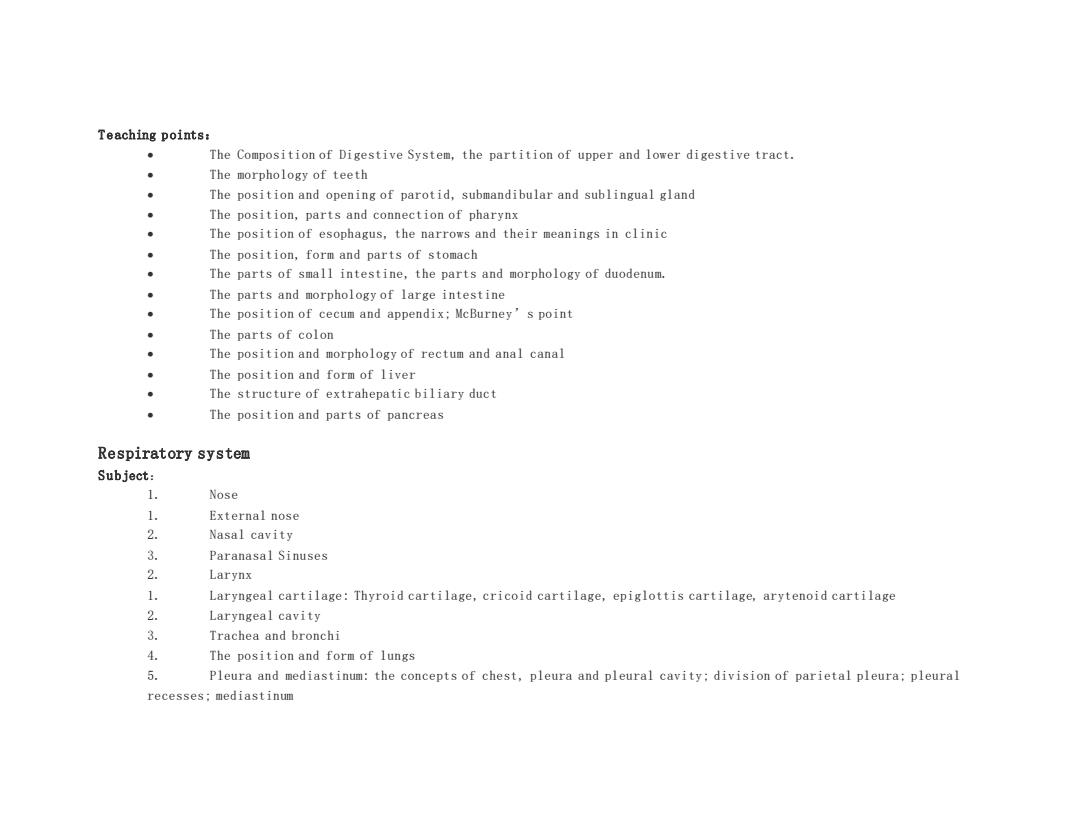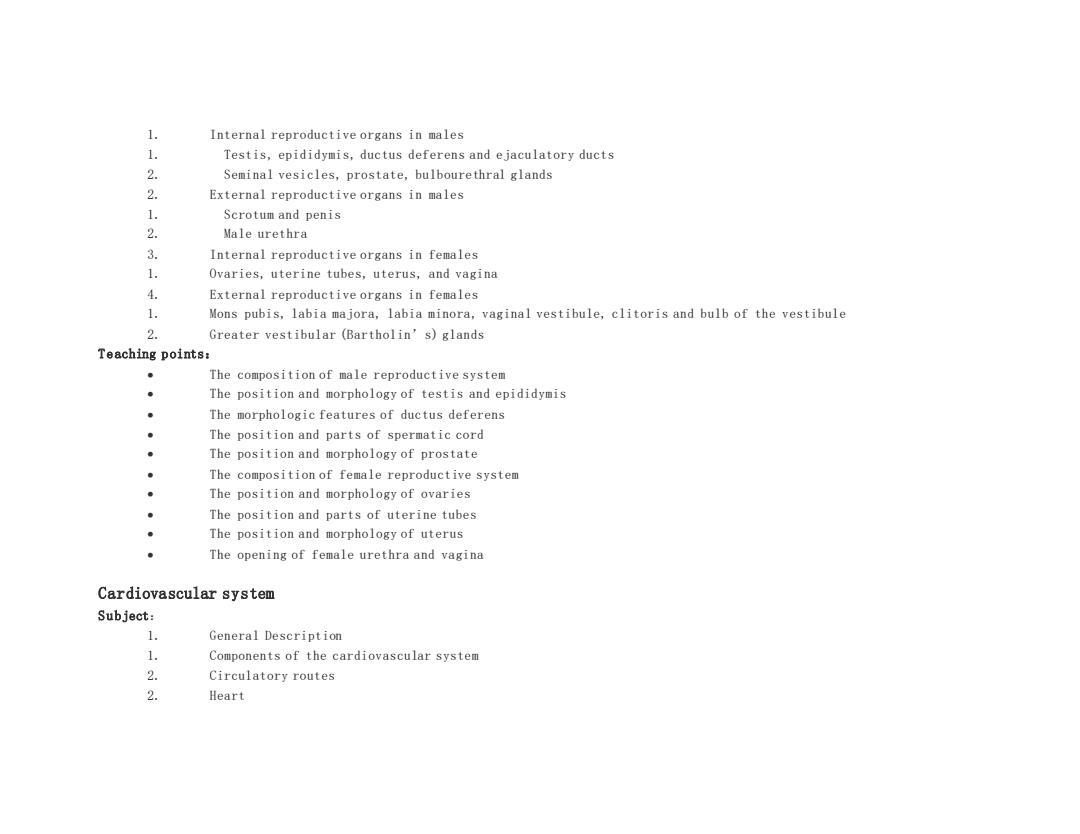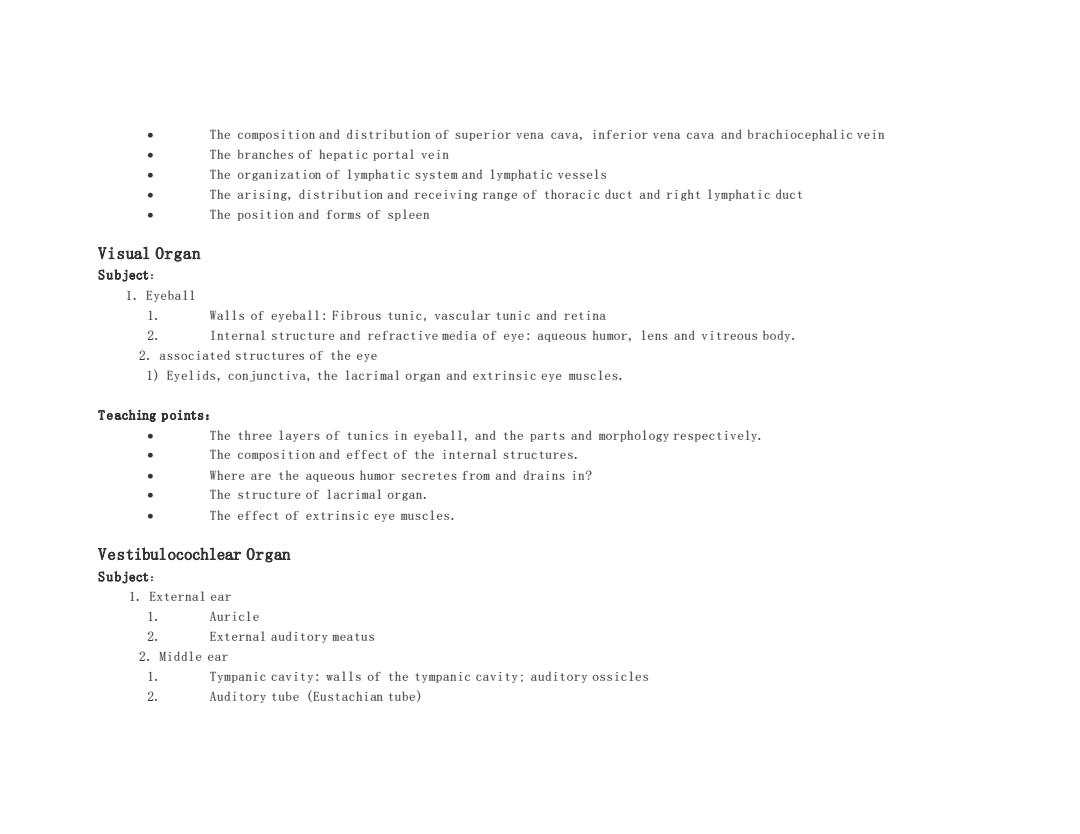
Teaching points: The Composition of Digestive System,the partition of upper and lower digestive tract. The morphology of teeth The position and opening of parotid,submandibular and sublingual gland The position,parts and connection of pharynx The position of esophagus,the narrows and their meanings in clinic The position,form and parts of stomach The parts of small intestine,the parts and morphology of duodenum. The parts and morphology of large intestine The position of cecum and appendix;McBurney's point The parts of colon The position and morphology of rectum and anal canal ● The position and form of liver The structure of extrahepatic biliary duct The position and parts of pancreas Respiratory system Subject: 1 Nose 1. External nose 2. Nasal cavity Paranasal Sinuses 2. Larynx 1. Laryngeal cartilage:Thyroid cartilage,cricoid cartilage,epiglottis cartilage,arytenoid cartilage 2. Laryngeal cavity 3. Trachea and bronchi w The position and form of lungs 5. Pleura and mediastinum:the concepts of chest,pleura and pleural cavity:division of parietal pleura;pleural recesses:mediastinum
T e aching p oints: • The Composition of Digestive System, the partition of upper and lower digestive tract. • The morphology of teeth • The position and opening of parotid, submandibular and sublingual gland • The position, parts and connection of pharynx • The position of esophagus, the narrows and their meanings in clinic • The position, form and parts of stomach • The parts of small intestine, the parts and morphology of duodenum. • The parts and morphology of large intestine • The position of cecum and appendix; McBurney’s point • The parts of colon • The position and morphology of rectum and anal canal • The position and form of liver • The structure of extrahepatic biliary duct • The position and parts of pancreas Respiratory system S u bject: 1. Nose 1. External nose 2. Nasal cavity 3. Paranasal Sinuses 2. Larynx 1. Laryngeal cartilage: Thyroid cartilage, cricoid cartilage, epiglottis cartilage, arytenoid cartilage 2. Laryngeal cavity 3. Trachea and bronchi 4. The position and form of lungs 5. Pleura and mediastinum: the concepts of chest, pleura and pleural cavity; division of parietal pleura; pleural recesses; mediastinum

Teaching points: The Composition of respiratory system,the partition of upper and lower respiratory tracts. The position and opening of paranasal sinuses The position and the cartilages framework of larynx:laryngeal cavity The position of trachea,the partition of left and right principal bronchus The position,morphology and shape of lungs The concepts of pleura and pleura cavity The division of pleura and costodiaphragmatic recess Urinary System Subject: Kidneys 1. The position,form and structure of kidney 2. Renal capsule:fibrous capsule,fatty capsule and renal fascia 2. Ureters 3. Urinary bladder 1. The position and shape of bladder 2. Trigone of bladder 4. Urethra Teaching points: The Composition of respiratory system The position and morphology of kidney Renal capsule The position of ureters the position and morphology of bladder The parts of urethra in males Reproductive System Subject:
T e aching p oints: • The Composition of respiratory system, the partition of upper and lower respiratory tracts. • The position and opening of paranasal sinuses • The position and the cartilages framework of larynx; laryngeal cavity • The position of trachea, the partition of left and right principal bronchus • The position, morphology and shape of lungs • The concepts of pleura and pleura cavity • The division of pleura and costodiaphragmatic recess Urinary System S u bject: 1. Kidneys 1. The position, form and structure of kidney 2. Renal capsule: fibrous capsule, fatty capsule and renal fascia 2. Ureters 3. Urinary bladder 1. The position and shape of bladder 2. Trigone of bladder 4. Urethra T e aching p oints: • The Composition of respiratory system • The position and morphology of kidney • Renal capsule • The position of ureters • the position and morphology of bladder • The parts of urethra in males Reproductive System S u bject:

1. Internal reproductive organs in males 1. Testis,epididymis,ductus deferens and ejaculatory ducts 2. Seminal vesicles,prostate,bulbourethral glands 2. External reproductive organs in males 1. Scrotum and penis 2. Male urethra 3. Internal reproductive organs in females 1 Ovaries,uterine tubes,uterus,and vagina 4. External reproductive organs in females 1. Mons pubis,labia majora,labia minora,vaginal vestibule,clitoris and bulb of the vestibule 2. Greater vestibular (Bartholin's)glands Teaching points: The composition of male reproductive system The position and morphology of testis and epididymis The morphologic features of ductus deferens The position and parts of spermatic cord The position and morphology of prostate The composition of female reproductive system The position and morphology of ovaries The position and parts of uterine tubes The position and morphology of uterus The opening of female urethra and vagina Cardiovascular system Subject: 1. General Description ( Components of the cardiovascular system 2. Circulatory routes 2. Heart
1. Internal reproductive organs in males 1. Testis, epididymis, ductus deferens and ejaculatory ducts 2. Seminal vesicles, prostate, bulbourethral glands 2. External reproductive organs in males 1. Scrotum and penis 2. Male urethra 3. Internal reproductive organs in females 1. Ovaries, uterine tubes, uterus, and vagina 4. External reproductive organs in females 1. Mons pubis, labia majora, labia minora, vaginal vestibule, clitoris and bulb of the vestibule 2. Greater vestibular (Bartholin’s) glands T e aching p oints: • The composition of male reproductive system • The position and morphology of testis and epididymis • The morphologic features of ductus deferens • The position and parts of spermatic cord • The position and morphology of prostate • The composition of female reproductive system • The position and morphology of ovaries • The position and parts of uterine tubes • The position and morphology of uterus • The opening of female urethra and vagina Cardiovascular system S u bject: 1. General Description 1. Components of the cardiovascular system 2. Circulatory routes 2. Heart

1)Location,shape and structure of the heart 2. Chambers of the heart:atrium and ventricle 3. Conduction system of the heart:SA node,AV node,bundle of His and Purkinje fibers 4. Coronary Circulation:arteries and veins 3.Artery 1. Arteries of the pulmonary circulation 2. Arteries of the systemic circulation:Aorta,arteries of the head and neck,arteries of the upper limbs,arteries of the chest,arteries of the abdominal region,arteries of the pelvic arteries,arteries of the lower limbs 4.Vein 1. Superior vena cava system:the veins of head and neck,the veins of the upper limbs and veins of the chest 2. Inferior vena cava system:the veins of the lower limbs,veins of the pelvis and the veins of the abdominal region 3. Hepatic portal system 5.Lymphatic system 1)General description 2) Lymph and lymphatic vessels:lymphatic Capillary,Iymphatic vessels,lymphatic trunks and lymphatic ducts 3) Lymph Nodes 4)Spleen and thymus Teaching points The composition of cardiovascular system The concepts of systemic circulation and pulmonary circulation The position,form of the heart:structure of heart chambers The structure and effect of Conduction system of the heart The arising,main trunks and distribution of left/right coronary arteries The location and opening of coronary sinus The arising,distribution and branches of aorta The distribution and branches of common carotid artery. The branches of external carotid artery and subclavian artery. The artery trunks of upper and lower limbs
1) Location, shape and structure of the heart 2. Chambers of the heart: atrium and ventricle 3. Conduction system of the heart: SA node, AV node, bundle of His and Purkinje fibers 4. Coronary Circulation: arteries and veins 3. Artery 1. Arteries of the pulmonary circulation 2. Arteries of the systemic circulation: Aorta, arteries of the head and neck, arteries of the upper limbs, arteries of the chest, arteries of the abdominal region, arteries of the pelvic arteries, arteries of th e lower limbs 4. Vein 1. Superior vena cava system: the veins of head and neck, the veins of the upper limbs and veins of the chest 2. Inferior vena cava system: the veins of the lower limbs, veins of the pelvis and the veins of the abdominal region 3. Hepatic portal system 5. Lymphatic system 1) General description 2) Lymph and lymphatic vessels: lymphatic Capillary, lymphatic vessels, lymphatic trunks and lymphatic ducts 3) Lymph Nodes 4) Spleen and thymus T e aching p oints • The composition of cardiovascular system • The concepts of systemic circulation and pulmonary circulation • The position, form of the heart; structure of heart chambers • The structure and effect of Conduction system of the heart • The arising, main trunks and distribution of left/right coronary arteries • The location and opening of coronary sinus • The arising, distribution and branches of aorta • The distribution and branches of common carotid artery. • The branches of external carotid artery and subclavian arter y. • The artery trunks of upper and lower limbs

The composition and distribution of superior vena cava,inferior vena cava and brachiocephalic vein The branches of hepatic portal vein The organization of lymphatic system and lymphatic vessels The arising,distribution and receiving range of thoracic duct and right lymphatic duct The position and forms of spleen Visual Organ Subject: I.Eyeball 1. Walls of eyeball:Fibrous tunic,vascular tunic and retina 2. Internal structure and refractive media of eye:aqueous humor,lens and vitreous body. 2.associated structures of the eye 1)Eyelids,conjunctiva,the lacrimal organ and extrinsic eye muscles. Teaching points: The three layers of tunics in eyeball,and the parts and morphology respectively. The composition and effect of the internal structures. Where are the aqueous humor secretes from and drains in? The structure of lacrimal organ. The effect of extrinsic eye muscles. Vestibulocochlear Organ Subject: 1.External ear 1. Auricle 2. External auditory meatus 2.Middle ear 1. Tympanic cavity:walls of the tympanic cavity:auditory ossicles 2. Auditory tube (Eustachian tube)
• The composition and distribution of superior vena cava, inferior vena cava and brachiocephalic vein • The branches of hepatic portal vein • The organization of lymphatic system and lymphatic vessels • The arising, distribution and receiving range of thoracic duct and right lymphatic duct • The position and forms of spleen Visual Organ S u bject: 1. Eyeball 1. Walls of eyeball: Fibrous tunic, vascular tunic and retina 2. Internal structure and refractive media of eye: aqueous humor, lens and vitreous body. 2. associated structures of the eye 1) Eyelids, conjunctiva, the lacrimal organ and extrinsic eye muscles. T e aching p oints: • The three layers of tunics in eyeball, and the parts and morphology respectively. • The composition and effect of the internal structures. • Where are the aqueous humor secretes from and drains in? • The structure of lacrimal organ. • The effect of extrinsic eye muscles. Vestibulocochlear Organ S u bject: 1. External ear 1. Auricle 2. External auditory meatus 2. Middle ear 1. Tympanic cavity: walls of the tympanic cavity; auditory ossicles 2. Auditory tube (Eustachian tube)